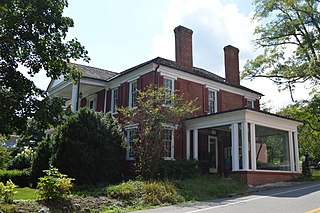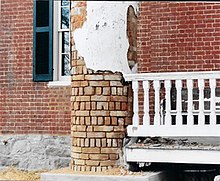
Greenbrier County is a county in the U.S. state of West Virginia. As of the 2020 census, the population was 32,977. Its county seat is Lewisburg. The county was formed in 1778 from Botetourt and Montgomery counties in Virginia.

Lewisburg is a city in and the county seat of Greenbrier County, West Virginia, United States. The population was 3,930 at the 2020 census.

The Diplomatic Reception Room is one of three oval rooms in the Executive Residence of the White House, the official home of the president of the United States. It is located on the ground floor and is used as an entrance from the South Lawn and a reception room for foreign ambassadors to present their credentials, a ceremony formerly conducted in the Blue Room. The room is the point of entry to the White House for a visiting head of state following the State Arrival Ceremony on the South Lawn. The room has four doors, which lead to the Map Room, the Center Hall, the China Room, and a vestibule that leads to the South Lawn.

Carnegie Hall, Inc. is a regional cultural center located in Lewisburg, West Virginia, United States. It is within the Allegheny Mountains. Monroe, Greenbrier, Pocahontas and Summers Counties are included in Carnegie Hall, Inc.’s primary service area. This region encompasses approximately 2,900 square miles (7,500 km2) and 73,000 people.

The Executive Residence is the central building of the White House complex located between the East Wing and West Wing. It is the most recognizable part of the complex, being the actual "house" part of the White House. This central building, first constructed from 1792 to 1800, is home to the president of the United States and the first family. The Executive Residence primarily occupies four floors: the ground floor, the state floor, the second floor, and the third floor. A two-story sub-basement with mezzanine, created during the 1948–1952 Truman reconstruction, is used for HVAC and mechanical systems, storage, and service areas.

The John Blake House is located on Homestead Avenue in Maybrook, New York, United States. It is a brick building from the late 18th century, one of the oldest houses in the village

The Wythe House is a historic house on the Palace Green in Colonial Williamsburg, in Williamsburg, Virginia, USA. Built in the 1750s, it was the home of George Wythe, signer of the Declaration of Independence and father of American jurisprudence. The property was declared a National Historic Landmark on April 15, 1970.

The Pearl S. Buck Birthplace is a historic home in Hillsboro, West Virginia where American writer Pearl S. Buck was born. The home now serves as a museum offering guided tours. The site also includes a carpentry shop and barn with over 100 historic farm and woodworking tools, and the log home of Buck's father's family, the Sydenstrickers, which was moved from Greenbrier County.

John Wesley Methodist Church, also known as First Methodist Church, is a historic Methodist church on E. Foster Street in Lewisburg, Greenbrier County, West Virginia. It was built in 1820, and is a two-story, brick meeting house building with Greek Revival style design elements. It originally measures 58 feet long by 47 feet wide. In 1835, a vestibule addition added 10 feet to the length. The interior features a "slave gallery." During the Battle of Lewisburg, a cannonball struck the southwest corner and the repairs remain visible.

The Durant House or Durant–Peterson House is a historic residence in unincorporated St. Charles Township, Illinois near St. Charles. It was listed on the National Register of Historic Places in 1976.
Morlunda, also known as the Col. Samuel McClung Place and Oscar Nelson Farm, is a historic home located near Lewisburg, Greenbrier County, West Virginia. It was built in 1827–1828, and consists of a main house with ell. The main house is a two-story brick building measuring 56 feet long and 21 feet deep. The ell measures 48 feet and it connects to a 1+1⁄2-story formerly detached kitchen.

The John A. North House is a historic house museum and archives located in Lewisburg, Greenbrier County, West Virginia. Currently, the North House is Greenbrier County's only historic house museum. Since 1976, The Greenbrier Historical Society has operated within the North House, and in 1992 the North House was officially purchased by the Greenbrier Historical Society. In 1992, the home officially became known as "North House Museum, Greenbrier Historical Society."

Greenbrier County Courthouse is a historic courthouse building located at Lewisburg, Greenbrier County, West Virginia. In 1973 the courthouse and the adjacent spring house, the Lewis Spring, were listed on the National Register of Historic Places. and are a historic and

Lewisburg Historic District is a national historic district located at Lewisburg, Greenbrier County, West Virginia. The district encompasses 112 contributing buildings and are representative of the development and evolution of Lewisburg, over a period of more than two centuries (1763-1977). Notable buildings include log cabins dating to the period 1755–1769, "The Barracks," Mount Esperance (1814), Williams-Henning Store/house (1814-1820), Welch-Bell House (1824), John W. Dunn House, John Withrow's Store/ House (1836), Greenbrier Valley Bank Building (1897), and Carnegie Hall (1902). Located in the district and separately listed are the Old Stone Church, Greenbrier County Courthouse and Lewis Spring, John Wesley Methodist Church, Gov. Samuel Price House, Mt. Tabor Baptist Church, Supreme Court Library Building, James Withrow House, and John A. North House.

Mason Mathews was an American merchant and politician in the U.S. State of Virginia. He served in the Virginia House of Delegates, representing Greenbrier County from 1859–1865 as a Whig. This period included the secession of Virginia and the resulting American Civil War of 1861–1865. Though Mathews opposed secession, he chose to support the Confederate States of America when Virginia seceded. Throughout the war, much of his efforts were directed toward the Confederate defense of western Virginia. When his home of Greenbrier County was taken into the new State of West Virginia in 1863, he continued to represent Greenbrier County in Virginia's Confederate legislature in Richmond until war's end. He was a member of the Mathews political family.
John Mathews was a 19th-century American surveyor, politician and lawyer. A Federalist, he was a member of the Virginia House of Delegates from Greenbrier County from 1798 to 1802, also serving as clerk of court for Greenbrier County from 1831 to 1849.

The Matthew Jones House is a historic plantation house located on Fort Eustis in Newport News, Virginia. The house sits on a hill toward the northern end of Mulberry Island, overlooking the James River. It was built ca. 1725 as a one-and-a-half-story frame dwelling with brick chimneys and later underwent two major renovations. During the first renovation, in 1730, the walls were bricked in and a shed room and porch tower were added. During the second, in 1893, the house was raised to a full two stories. In 1918 the house and its surrounding land were acquired by the U.S. government for the establishment of an army post. By the late twentieth century, the Matthew Jones House had fallen into grave disrepair. In 1993 it was preserved and rehabilitated by the National Park Service in cooperation with the U.S. Army Corps of Engineers. Today it serves as an architectural museum.
Benjamin Deyerle (1806–1883) was an architect, artist and brickmaker in Roanoke County, Virginia. Many of the historic homes, churches and public buildings in Roanoke were designed and built under his and his family's direction. He is credited with building 23 of them, and perhaps more. Some of these homes and buildings are currently listed on both the National Register of Historic Places and the Virginia Landmarks Register.

The Rosa L. (McCauley) and Raymond Parks Flat, or simply the Rosa Parks Flat, is a two-story brick duplex located at 3201-3203 Virginia Park Street in Detroit, Michigan. The building is significant as the home of civil rights icon Rosa Parks, who lived in the first floor flat with her husband Raymond from 1961 to 1988. The building was listed on the National Register of Historic Places in 2021.

Greenbrier College was a women's college in Lewisburg, West Virginia in the United States from 1812 to 1972. It started as Lewisburg Academy and when the school closed during the US Civil War, it reopened in 1875 it split into two schools: the Greenbrier College for Women and the Greenbrier Military School. The Greenbrier College also went by the Lewisburg Female Institute and Lewisburg Female Seminary.

























